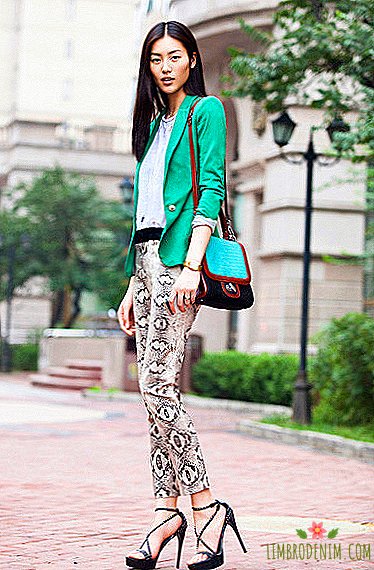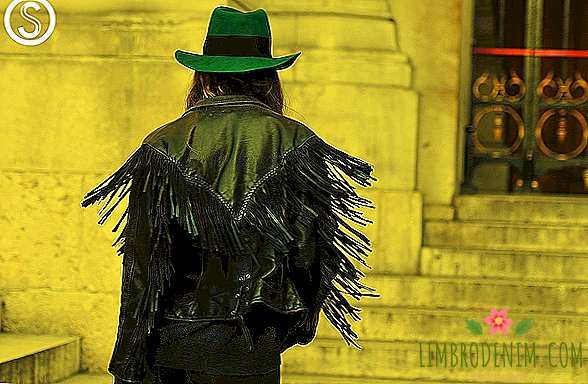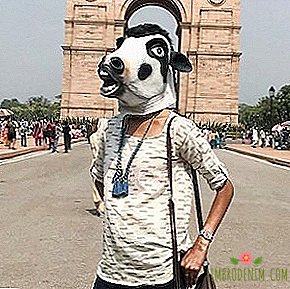“This clothes are not for fuss”: I am doing a retromarket in Russia
Waist dresses, skirts, light overalls - Muscovite Ekaterina Blinova works in retro-aesthetics unusual for Russia and gives the second life to the original silhouettes of the 50s and 60s. Among the clients of her brand Ginger Jackie - blogger Aida Dapo and dancer Dita Von Teese. We asked the designer where to look for characteristic fabrics, what are the difficulties with retrofitting and who buys her works.
TEXT: Svetlana Paderina

Start
I had a talent for needlework since childhood. I became interested in sewing in the "puppet" period: I made everything myself, and each time the dresses for dolls became only more complicated. I successfully graduated from an art school and entered the Kosygin Textile Institute: I went to study for an ornamental artist when I failed to go to a fashion designer. My specialization is the development of prints and patterns for fabrics that are used in creating clothes. After the institute, I tried myself in different areas, including doing airbrushing and painting motorcycles, cars, and even T-shirts. Together with my husband, we invented the Ginger Jack brand: my husband brought ideas, and I thought through models of wallets and other accessories made of thick leather with embossing and painting. When my friends and I began to go to music festivals in the style of the 50s, the question arose - what to wear? And since I already had a little experience, I began to sew retro-drafts, focusing on illustrative material.
At first it was hard to find sources: our retroculture is less developed than in Europe or America. Then there were no cool vintage shops where you could see things, touch them, understand how they are designed and sewn. I was looking for patterns and old magazines on eBay, once I even ordered fabrics from Hawaii. "Jack" turned into "Jackie" when I realized that I was doing a lot of such retro clothes - however, these were not complete collections, but just a few models, sewn in two or three copies.
Promotion
The name suited to what was at the very beginning: colorful dresses in the style of the 50s, breeches with wavy braid, bolero, short light overalls, everything playful, festival. Simple, bright models, in which there was more frivolous styling than a verified style. With these things, I went to foreign markets, studied demand. In Russia, my friends first bought my clothes, and then word of mouth worked, people came up and asked: "What kind of dress do you have? Can I make such a stitch?" I started promoting Ginger Jackie on portals such as "Fair Masters" or VKontakte groups. "Fair Masters" I still use, to be honest, there is a storehouse of a variety of customers. For example, I have some very rich clients who are sitting at the Fair.
With the advent of instagram, it has become much easier: you post work - and you already know about you. I tried to communicate with foreign bloggers: they are light on their feet, absolutely devoid of snobbery and do not roll out the price tag for publication instead of greeting. I studied how they use such elements in modern clothes, yet finding the edge between retro-look and outfit from both dusty grandmother's chest is not easy. I signed, watched them, commented, and they commented in response and were surprised that in Russia they sew. I was one of the first to start a retrostyle in the country. In 2013, the first full-fledged collection of Ginger Jackie came out, some of which I still repeat.
Let's just say: I can sew quality things with my own hands, but I have a big gap in marketing, in organizational matters. There are designers, and there are entrepreneurs. An entrepreneur is a person who feels how to sell, how to promote, how to develop. And the designer is more about creative searches, when you fight so that everything looks perfect, sits well, and this is far from earning. It is not enough to do just good things - you need to turn your thinking around so that you understand what your product is, who your audience is, how to interest it. At some point, you start to get tired of the fact that this profession does not look like a picture from magazines and films. Of course, if there is an investment, then business processes will turn around much faster than when you yourself go slowly toward your goal.
Patterns and models
I work with models of clothes of the 20th century - I make replicas of things from the 40s – 60s and I don’t see anything wrong with that: so I learn to feel the form, the proportions. It is interesting to me to take a picture and implement it. Clients often ask me to sew a suit, dress or coat "as in the photo." I even get a little upset when in the process of working the client asks to change something, because it is interesting to me to recreate the thing, verified by the silhouette and details. I indicate authorship everywhere, I write that this is a replica, and not my own design. For example, my favorite skirt "Dorothy" was restored by the museum patterns of Charles James, the blessing patterns can be explored on the site of the Metropolitan Museum. In general, I have a large collection of patterns from the 40s and 50s, and in part with their help I develop my models. When you study this amount of material, you begin to notice the nuances that you want to introduce: an unusual arrangement of tucks or a new cut of the sleeve. Then, in the process of selecting the fabric, the accumulated ideas begin to form a picture, into a product.
All that can be studied, I study: collections of fashion museums that scan patterns, illustrations, photos. Auctions are also an excellent information base: for sale, people photograph a thing on a dummy in good resolution, turn it inside out, thoroughly documenting the elements. Vintage magazines, the benefit is now a lot of enthusiasts who post them on the Internet. When traveling abroad, I will definitely find museums, tissue markets, vintage shops - I love to dig in them, although I don’t buy anything.
Today, the proportions of female figures have changed - it is useless to take retrotroops and try to use them in production in its pure form. In the middle of the last century, women were lower, they had narrower and high-set waist, another shoulder girdle, and another spread of shoulders. Modern figures are more athletic, with less emphasis on the waist, they have more straight and developed shoulders. This becomes noticeable if you try on the original dress of the 50s.
According to my feelings, customers like everything created according to the canons - with petticoats, linings, corsets and other retro elements. Previously, such clothes had a frame of linen and means for giving volume: corsage, linings, petticoats. Bras had a special shape - the breasts were high and sharp - now they don’t wear such underwear. In the 50s, the sloping shoulders were in fashion, so one of the favorite designs was a one-piece sleeve. To achieve a similar silhouette, it is necessary to be cunning: for example, to use formative elements to create a steep hip, since the waist is not tightened now. To create a sharp drop between the waist and the hips, I “hang up” the jacket or side of the puffy skirts and use an amplifier that helps to make the hem stiffer.
Production
I use Italian stock fabrics, that is, materials left over from the production of other brands. It is difficult to find permanent collections of textiles: what suits the quality is sold from a thousand meters per item, plus it needs to be brought to Russia and customs cleared. Therefore, I use drains and can sew only a limited number of things, especially considering the high consumption of fabric. One-piece sleeves and puffy skirts gobble up the lion's share of the footage - sometimes it turns out that only ten items can come out of one roll at thirty to forty meters. The materials are, of course, modern, but I try to look for ornaments in a retrostyle or choose classics like peas, stripes, and cages.
Ginger Jackie collections are made in a modest range. I love neutral shades, from bright colors I choose only red - however, in the new line I want to introduce dark blue as an alternative to black. Occasionally I work with vintage materials: acquaintances often bring fabrics, lace, buttons from grandma's stocks, and I use something that is in good condition. In the case of old tissues, there is a problem: they were shifted by mothballs for preservation, and this smell does not appear at all; they often lose color and strength. I tried to print a roll with my own print, but the quality did not suit me. Embroidery is another matter - I paint ornaments on my own, digitize them and bring them to production. So in the collections there are elements of machine embroidery, which makes things special.
Now there are four people in the team. In addition, there are people at outsourcing who make gradation patterns or advise on various issues. There is also a third-party production, which wets out products as needed, because our workshop produces the main circulation. Probably, from a business point of view, it would be wiser to rent a showroom in the center of Moscow, take orders there and donate them for production, rather than spend money on renting premises for a workshop, depreciating equipment, salary by a tailor, and so on. But I do not want to move away from the creation of things: I love being in the studio, besides, customers come to talk to me about private orders. When asking questions on Instagram, I’m always happy to answer. I like to establish a dialogue with colleagues, designers, production workers - the exchange of experience is very important.
Female customers
Someone is ready to wear retro dresses every day, someone chooses these outfits for special occasions. Very young customers rarely come to me, but sometimes clients bring daughters who need outfits for graduation or home parties. In any case, this clothing is not for fuss, but for special events when you want to pamper yourself. Approximately half of the purchases are private orders by individual measurements, because complex silhouettes do not fit universally on any type of figure. Recently, a girl came from Ireland specifically to try on a wedding dress. We sew and remotely: for example, we had a customer from Atlanta, who said that in America the price for such targeted tailoring would be like that of a large fashion house. We sewed a dress without fitting - Gabriela has already sent photos from the wedding.
Brand ambassadors are mostly foreign bloggers. For Aida Dapo, we made a wedding dress, pink - now almost every month we are asked to wear a dress like hers, although it will not be possible to repeat it. I communicate directly with my muse with Dita Von Teese: she has already appeared in Ginger Jackie clothes and now wants to order a coat — we are discussing the model and are planning to finally meet in person. In general, foreigners buy a lot, it’s a pity that the store in Munich was closed, where we supplied the collections. I would like to present the brand somewhere else, because the customs duties in the European Union are high - the buyer must pay an additional 20-30% of the cost, which we always warn about. Still, things are cheaper than those of similar European brands. There is even a separate category of customers who regularly buy several items from each collection, actively mark us on Instagram and ask to open an offline store in their city.
PHOTO: Gingerjackie





